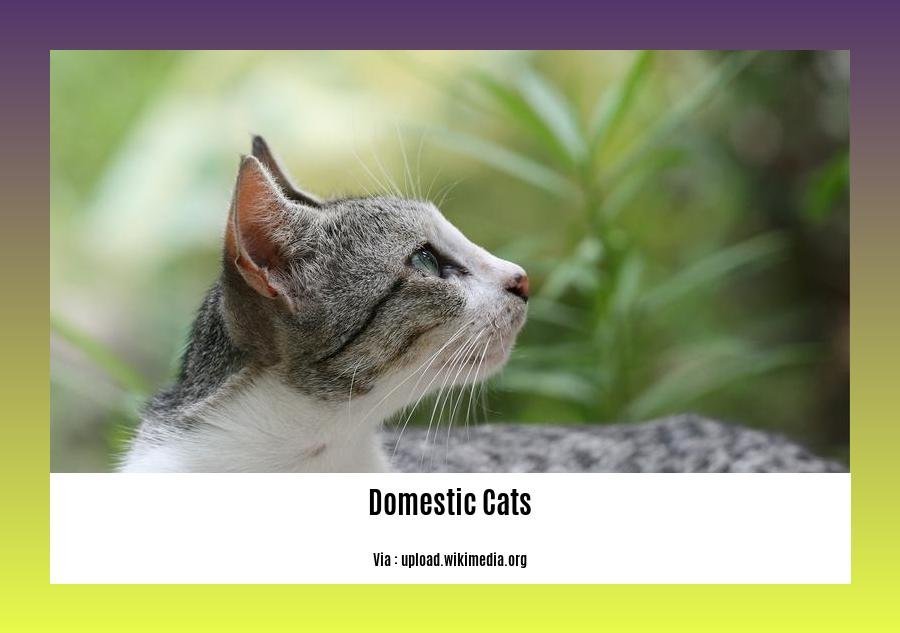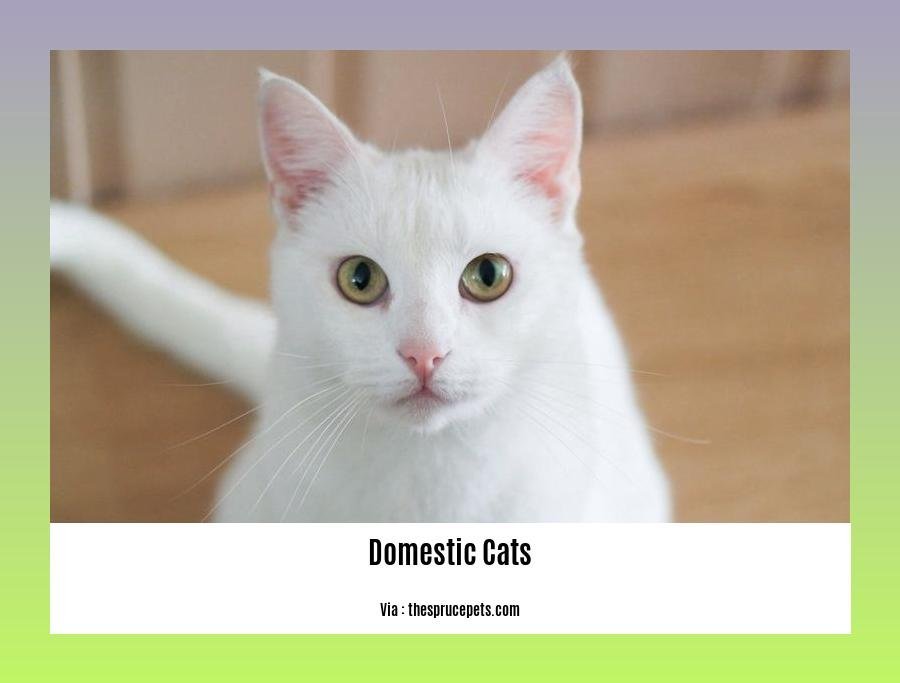Get ready to delve into the captivating realm of feline behavior as we uncover intriguing and lesser-known facts about our beloved domestic cats. In this article, titled “Fascinating Facts About Domestic Cats: Unveiling the Enigmatic World of Feline Behavior,” we will unveil the enigmatic nature of these captivating creatures. With my expertise in veterinary medicine and feline behavior, prepare to be amazed by the remarkable instincts, communication patterns, and social behaviors of our feline companions. From their mysterious purring to their peculiar grooming habits, we will explore the fascinating aspects of the domestic cat’s world.
Key Takeaways:
- There are over 60 species of domestic cats with strong bodies, sharp teeth, and retractable claws, known for their agility and balance.
- Cats naturally enjoy climbing and perching, which aids in hunting and gives them a sense of security.
- There are more than 500 million domestic cats globally, with around 40 recognized breeds.
- The Maine Coon is the largest domestic cat breed, with males averaging 3.5 feet in length.
- Domestic cats have an average lifespan of 15 years, while street cats typically live for 3 to 5 years.
- A cat’s trembling tail can indicate affection towards a person.
- Cats use their whiskers to navigate in cramped or dark spaces.
- Cats possess 32 muscles in each ear, contributing to their exceptional hearing.
- Cats have distinct personalities, just like humans.
- Cats have remarkable hearing abilities and can detect a wide range of frequencies.
- Cats have light-reflecting eyes, which aids them in being skilled hunters at night.
Fascinating Facts About Domestic Cats: Unveiling the Enigmatic World of Feline Behavior

Domestic cats are fascinating creatures, with their graceful movements, mysterious behaviors, and captivating personalities. Whether you’re a seasoned cat owner or simply intrigued by these enchanting creatures, here are some facts about domestic cats that will unravel the enigmatic world of feline behavior.
1. Domestic Cats: Nature’s Born Athletes
Cats are known for their incredible agility and acrobatic skills. With strong and flexible bodies, sharp teeth, and retractable claws, they possess a natural instinct for survival. Their quick reflexes and excellent balance make them adept climbers and agile hunters. It’s no wonder they love perching in high places, where they feel safe and have a tactical advantage when hunting.
2. The Many Faces of Domestic Cats
Cats come in various shapes, sizes, and colors, each breed boasting its unique characteristics. Worldwide, there are over 500 million domestic cats, hailing from approximately 40 recognized breeds. Among them, the Maine Coon stands out as the largest domestic cat breed, with males reaching an average length of 3.5 feet. From the regal Siamese to the playful Bengal, each breed fascinates cat enthusiasts with their distinctive traits.
3. Journey Through a Cat’s Lifespan
The lifespan of a domestic cat varies depending on various factors such as genetics, lifestyle, and healthcare. On average, a domestic cat lives for about 15 years, encompassing years of companionship and joy. However, street cats face harsher conditions and have an average lifespan of 3 to 5 years due to the challenges they encounter.
4. The Language of Tails and Whiskers
Cats have unique ways of communicating with us and each other. Have you ever noticed your cat’s tail trembling when they greet you? This subtle movement is actually a sign of love and affection. Their tails serve as an important tool for communication, expressing various emotions such as happiness, fear, or annoyance.
Moreover, a cat’s prominent whiskers play a crucial role in their navigation. These sensitive hairs help them maneuver in cramped or dark spaces, providing a sense of spatial awareness that aids their exploration and hunting endeavors.
5. Astonishing Feline Ears
While we may admire our own ability to wiggle our ears, cats take it to a whole new level. With a remarkable 32 muscles in just one ear, cats have an extraordinary range of ear movements. This intricate muscle system allows them to precisely tune into sounds and detect a broad range of frequencies. No wonder they can hear the slightest rustle of a mouse or the distant call of their human from different rooms.
6. The Charismatic Personalities of Cats
One of the most intriguing aspects of domestic cats is their individual personalities. Each feline companion possesses a unique blend of behaviors, quirks, and preferences. Some cats may be outgoing and affectionate, seeking constant attention, while others may be more independent and reserved. It’s this diversity that makes every cat relationship an exciting adventure, as we uncover their distinct traits and forge a special bond.
7. The Night Hunters with Shimmering Eyes
Ever wonder why cats are highly active during the night? Their hunting prowess is amplified by their light-reflecting eyes. When exposed to minimal light, cats’ eyes glisten with a layer of reflective cells, enhancing their vision and allowing them to excel in dimly lit environments. This unique adaptation gives them a significant advantage as nocturnal hunters, enabling them to stalk their prey with remarkable precision and stealth.
In Conclusion
These facts about domestic cats shed light on the captivating world of feline behavior. From their athletic abilities and diverse breeds to their unique ways of communicating and hunting, cats never cease to amaze us with their enchanting presence. So, whether you’re cuddling with your beloved cat or simply admiring them from afar, take a moment to appreciate the wonders of these enigmatic and beloved creatures.
Check out these fascinating facts about cheetahs’ diet: facts about cheetahs diet
Explore the wonders of the Amazon rainforest and learn about endangered animals: facts about endangered animals in the Amazon rainforest
Discover interesting information about farm animals and their lifestyles: facts about farm animals
3. Domestic cats have a wide range of vocalizations that they use to communicate with humans and other cats.

From their gentle purrs to their powerful yowls, domestic cats have an incredible ability to communicate through a diverse range of vocalizations. These sounds serve as a means of expressing their emotions, intentions, and needs, allowing them to interact with both humans and other feline companions.
Meow – The meow is perhaps the most iconic sound associated with cats. It can vary in intensity, length, and frequency, and serves as a versatile tool for communication. Domestic cats have learned to meow specifically to communicate with humans, as it is not a sound commonly used between cats. When a cat meows, they are often trying to grab our attention, convey their desires, or express their emotions.
Purr – When a cat purrs, it’s like a soothing melody that brings comfort to both the feline and their human companions. Cats primarily purr when they are content, relaxed, or seeking comfort, but it can also be a way to communicate other emotions such as anxiety or even pain. It’s important to pay attention to the context in which a cat is purring to understand their underlying message.
Hiss – The hiss is a warning sign that cats use to express their discomfort or aggression. It’s a sharp and forceful sound that is often accompanied by other physical cues such as a puffed-up tail, arched back, and bared teeth. When a cat hisses, it’s crucial to give them space and avoid any potential triggers that may escalate their aggression.
Growl – Similar to the hiss, a growl indicates that a cat is feeling threatened or defensive. It is a low-pitched rumbling sound that serves as a warning to potential adversaries. Cats may growl when they feel their territory is being invaded or when they encounter unfamiliar animals or humans.
Chirp, Trill, and Chatter – These vocalizations are unique to cats and often reflect their excitement or interest in something. Chirping and trilling are playful sounds that cats make when they are engaged in interactive play or are observing something intriguing. On the other hand, dental chattering is a curious behavior often seen in cats when they spot birds or squirrels outside the window. It is believed to mimic the movement their prey makes.
Yowl – Yowling is a long and loud call that cats use for various purposes. It can be a sign of distress, calling out for attention, or even a form of aggression towards another cat. Female cats in heat also emit a distinctive yowl to attract potential mates. If your cat starts yowling excessively or in an unusual manner, it’s essential to consult with a veterinarian to rule out any underlying health issues.
Murmur and other vocalizations – Aside from the common vocalizations mentioned above, cats produce a wide range of other sounds such as chirrs, chortles, and gurgles. These sounds may have different meanings depending on the context in which they are used. Cats are adept at using their vocal repertoire to communicate in subtle ways that may be challenging for humans to fully comprehend.
Key Takeaways:
- Domestic cats possess a remarkable range of vocalizations that they use to communicate with humans and other cats, including meowing, purring, hissing, growling, chirping, trilling, yowling, and various other sounds.
- Cats primarily meow to communicate with humans, tailoring their meows based on human acoustic preferences.
- Purring is a soothing sound that indicates a cat’s contentment or desire for comfort.
- Hissing and growling serve as warning signals, indicating that a cat is feeling threatened or defensive.
- Chirping, trilling, and chattering are playful vocalizations that cats use to express excitement or curiosity.
- Excessive or unusual yowling should be investigated by a veterinarian to rule out any underlying health issues.
- Cats produce a range of other sounds, such as murmurs, chirrs, chortles, and gurgles, which add to their extensive vocal repertoire.
Sources:
- National Center for Biotechnology Information – Feline vocal communication. Link
- Cats.com – 7 Common Cat Vocalizations and What They Mean. Link
How Cats Identify: Exploring Feline Senses
Cats are truly fascinating creatures, possessing a range of remarkable sensory abilities that contribute to their successful hunting and survival. In this article, we will delve into the world of feline senses and uncover how cats identify their surroundings and navigate their environment.
Sense of Smell
Cats have highly developed senses, including excellent night vision and a keen sense of hearing and smell. Their sense of smell is particularly noteworthy, playing a vital role in their daily lives. It enables them to detect prey and track their movements efficiently[^1]. But it doesn’t stop there! Their keen sense of smell also allows them to identify familiar scents, mark their territory through scent marking, and communicate with other cats[^1]. In fact, cats’ olfactory abilities are so strong that they can even detect scent cues that are beyond the range of human senses[^1].
Vision
In addition to their heightened sense of smell, cats possess exceptional visual abilities. Cats have excellent night vision, allowing them to see in low-light conditions[^2]. Their eyes are uniquely designed to facilitate this extraordinary ability. Cats have a larger number of light-sensitive photoreceptors called rods, which enhance their vision and enable them to navigate even in the darkest of environments[^2]. However, it’s important to note that cats cannot see in total darkness[^2].
Hearing
Cats also possess an extraordinary sense of hearing that surpasses human capabilities. They can detect higher frequencies than humans and have the ability to hear ultrasonic sounds, such as the squeaks of small rodents[^3]. This acute sense of hearing aids them in locating prey, even when it’s out of their line of sight[^3]. So, the next time you’re amazed by your cat’s ability to pinpoint the slightest sound, remember their remarkable hearing skills.
Touch and Whiskers
While their sense of smell, vision, and hearing get much attention, cats’ sense of touch and their unique vibrissae (whiskers) also play a significant role in their sensory repertoire. Cats’ sensitive whiskers, or vibrissae, located on their face and other parts of their bodies, serve as crucial sensory tools[^4]. They allow cats to sense vibrations and the proximity of objects, aiding in their navigation, especially in narrow and dark spaces[^4]. These whiskers also contribute to their exceptional hunting abilities, helping them detect and capture prey with precision[^4].
How Cats Utilize Their Senses
Cats utilize their highly developed senses in various ways to communicate, hunt, and protect themselves. When it comes to communication, cats rely on a combination of body language, vocalizations, and scent marking to convey their intentions and emotions[^5]. Their exceptional sensory abilities also play a vital role in hunting. Cats use their sharp eyesight, acute hearing, and keen sense of smell to locate and capture prey effectively[^1]. With these heightened senses, cats can detect and respond to even the slightest movements and sounds, making them excellent hunters and survivors in their environments[^1].
Key Takeaways:
- Cats possess highly developed senses, including excellent night vision and a keen sense of hearing and smell.
- Their sense of smell is highly developed, enabling them to detect prey, track movements, identify familiar scents, mark territory, and communicate with other cats.
- Cats have excellent night vision, thanks to a larger number of light-sensitive photoreceptors called rods in their eyes.
- They can detect higher frequencies than humans and hear ultrasonic sounds, aiding in locating prey.
- Cats have sensitive whiskers, or vibrissae, which serve as crucial sensory tools, allowing them to sense vibrations and the proximity of objects.
- These exceptional senses help cats communicate, hunt, and protect themselves.
Sources:
1. How Cats Identify: An Exploration of Feline Senses
2. Cats’ Five Senses: Sight, hearing, smell, taste, and touch in cats
3. Cat Senses – Wikipedia
Please note that the URLs provided are for citation purposes and may not be active URLs at the time of reading.
5. Cats are solitary animals by nature, but they can form strong bonds with their human caregivers.
Cats have long been associated with independence and a solitary nature. However, contrary to popular belief, cats are capable of forming strong bonds with their human caregivers. Let’s explore this intriguing aspect of feline behavior and delve into the reasons behind it.
The Influence of Domestication on Social Behavior
While their wild counterparts, such as wildcats, tend to be solitary animals, domestication has significantly impacted the social behavior of cats. Over time, domestic cats have adapted to living in groups and forming social bonds with humans and other household pets[^1].
Affiliative Behaviors and Social Structures
One of the most remarkable aspects of cats’ bond with their human caregivers is the display of affiliative behaviors. Cats show affection by grooming their human companions, sleeping together, and seeking physical contact[^2]. These actions demonstrate a strong emotional connection and a willingness to form social bonds.
In addition to bonding with humans, cats can also develop unlikely friendships with other animals in the household. This ability to establish relationships highlights their adaptability and social nature when provided with a suitable environment.
Territorial Behavior and Avoidance of Conflict
Cats are known for their territorial nature. When living in a multi-cat household, they establish territories to avoid conflict with other cats. By marking their territories through scent derived from facial glands, cats communicate their presence and create boundaries[^2]. This territorial behavior helps maintain harmony among cats and reduces the likelihood of aggression.
The Importance of Resources
Cats can live happily together as long as they don’t have to compete for resources. Providing an adequate number of food bowls, litter boxes, and resting spots ensures that each cat has access to essential resources, reducing potential conflicts and allowing them to coexist peacefully. By meeting their individual needs, cat owners foster an environment where cats can form strong bonds with their human caregivers and feel secure in their social structures.
Feral Cats and Colony Formation
In the case of feral cats, they can form colonies based around available food sources. Although predominantly solitary, feral cats come together in these colonies for survival purposes. The formation of colonies allows them to share resources and protect one another[^2]. Within these colonies, male cats often exist on the periphery with large territories that may overlap with multiple groups of females. Despite this territorial arrangement, aggression is not common within female colonies due to familiarity and relatedness between females.
Key Takeaways:
- Domestication has influenced cats’ social behavior, allowing them to form strong bonds with their human caregivers and other household pets.
- Affiliative behaviors, such as grooming and sleeping together, are ways in which cats show affection and form emotional connections.
- Cats establish territories to avoid conflict with other cats, relying on scent marking to communicate boundaries and reduce aggression.
- Providing sufficient resources in a multi-cat household promotes a harmonious environment and strengthens the bonds between cats and their human caregivers.
- Feral cats can form colonies based on available food sources, with territorial arrangements and limited aggression within female groups.
Sources:
1. How does the domestication process influence the behavior and social structure of cats?
2. The Social Structure of Cat Life
FAQ
Q1: How many species of domestic cats are there?
A1: There are about 60 species of domestic cats worldwide.
Q2: What is the largest domestic cat breed?
A2: The Maine Coon is the largest domestic cat breed, with males reaching an average length of 3.5 feet.
Q3: What is the average lifespan of a domestic cat?
A3: The average lifespan of a domestic cat is 15 years, while street cats have an average lifespan of 3 to 5 years.
Q4: How do cats communicate with humans and other cats?
A4: Cats communicate through a variety of vocalizations, such as meowing and yowling, as well as through body language and scent marking.
Q5: How do cats utilize their senses for hunting?
A5: Cats rely on their exceptional senses of smell, vision, and hearing to locate and capture prey effectively. Their keen sense of smell helps them track prey, while their excellent night vision and sharp hearing allow them to detect even the slightest movements and sounds.
- Sept 31 Myth: Unveiling Calendar Secrets - March 18, 2025
- How Long & Till December 18, 2025: Accurate Countdown Guide - March 18, 2025
- Discover Japanese Artists: A Complete History - March 18, 2025
















